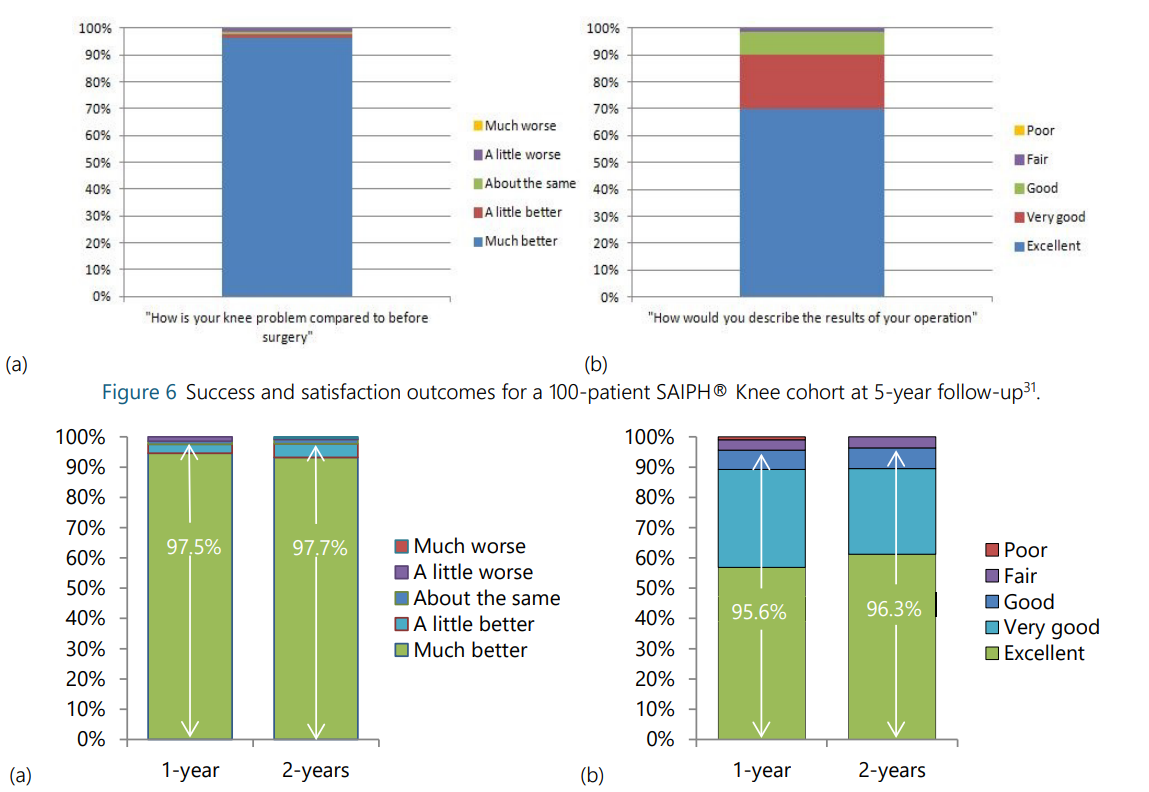Patient Reported Outcome Measures (PROMs)
- Products
- SAIPH® Knee System
- PROMs
In their 2-year follow up study, Walter et al. used a visual analogue scale (VAS) for patient satisfaction and found that 95.3% responded positively (responding 8-10 on a 10-point scale), which they commented was unusual in their previous knee cohorts and was equivalent to satisfaction responses for their own hip cohorts (95.2%) at the same timepoint29. In their stability study of 60 patients Jacobs et al. found that patients with SAIPH® Knees were more likely to be satisfied with their outcome than patients with non-medially stabilised knees (>7.5 VAS satisfaction: 97% SAIPH® vs 83% other; p=0.08), which became significant (p=0.048) when comparing all stable to all unstable knees in their study27. In one surgeon’s consecutive series comparing SAIPH® patients with those who had received his established device, SAIPH® patients scored mean 9.3 on the same VAS-satisfaction scale28.
In their 5-year postoperative data for a cohort of 100 SAIPH® Knees, Katchky et al. found that when asked: “How would you describe the results of your operation?” (Success), 98% of patients responded that the results of their operation were ‘good’ to ‘excellent’ (Figure 6) 31. In their 274-patient multicentre study, Bare et al. reported an equally high degree of satisfaction: 96.4% of patients described the results of their operation as ‘good’ to ‘excellent’ (Figure 7) 32.
When asked “Overall, how are your problems now compared to before your operation?” (Satisfaction), Katchky et al. reported that 98% of patients responded with ‘much better’ (Figure 6) 31. Bare et al. found 97.2% of their patients said their problems were ‘better than before surgery’ with 92.6% saying ‘much better’ 2 years after their surgery (Figure 7) 32. Bare et al. reported that results were reproducible for all surgeons: median satisfaction for every surgeon’s cohort was ≥9 out of 1032. Unlike recent reports on patient satisfaction after total knee replacement40,41,42, SAIPH® Knee cohorts do not display a 15-20% dissatisfaction rate27,28,29,30,32.
display a 15-20% dissatisfaction rate.

Figure 7 Patient satisfaction: (a) “overall, how are your problems now, compared to before your knee replacement?” and
(b) “how would you describe the results of your knee replacement?”32.
References
27. Jacobs H, Jones C, Brighton R, Redgment A, Talbot S and Walter WL. Sagittal Stability: KT1000 and PROMs. Presented at the Forever Active Forum, Valencia, 2019.
28. French SR, Munir DS and Brighton R. A Single Surgeon Series comparing the Outcomes of a Cruciate Retaining and Medially-Stabilised Total Knee Arthroplasty using Kinematic Alignment Principles. J. Arth. 2019; doi: https://doi.org/10.1016/j.arth.2019.09.021.
29. Walter WL, Shimmin A, Richards L and McDonald L. SAIPH® Medial Ball and Socket Knee: 2-year Follow-Up of the First 200 Patients. Presented at the AOA ASM, Brisbane, 2016.
30. Katchky AM, Jones CW, Walter WL, Shimmin AS. Medial ball and socket total knee arthroplasty. Five-year clinical results. Bone Joint J. 2019; 101-B (1 Supple A): 59-65.
31. Katchky A, Shimmin A, Jones C and Walter WL. Minimum 5-year Follow-Up of the SAIPH® Medial Ball and Socket TKR. Presented at the AOA ASM, Adelaide, 2017.
32. Baré J. The SAIPH medial stabilized total knee arthroplasty: A multi-centre 2-year outcome study across Australia & New Zealand. Presented at Arthroplasty Society of Australia ASM, Adelaide, 2021
Resources
SAIPH® Clinical Rationale
SAIPH® Flyer
SAIPH® Operative Technique
Download Now
Fill in your details below to download the SAIPH® Clinical Rationale
Additional Text
Download Now
Fill in your details below to download the SAIPH® Flyer.
Additional Text
Download Now
Fill in your details below to download the SAIPH® Operative Technique
Additional Text
Longevity of the SAIPH® Medially Stabilised Knee
Other manufacturers have introduced a ball-and-socket asymmetric tibial constraint to platforms with a traditional ‘keel’ tibial design used on unconstrained bearing options. Some have also produced cementless component versions. Higher revision rates17,43, particularly tibial loosening44 have been associated with these combined design characteristics.